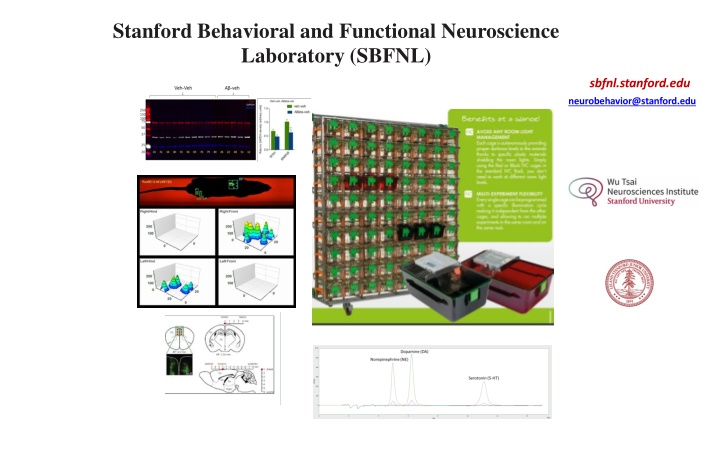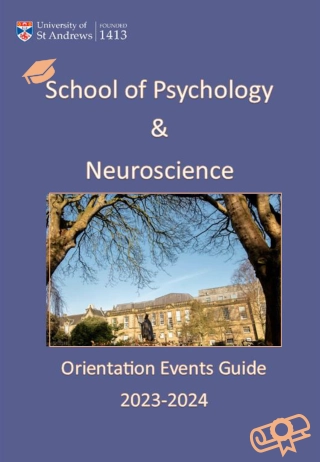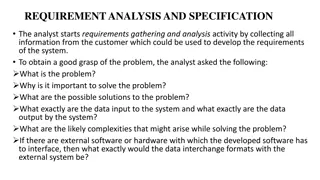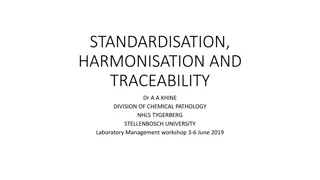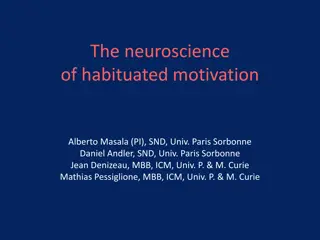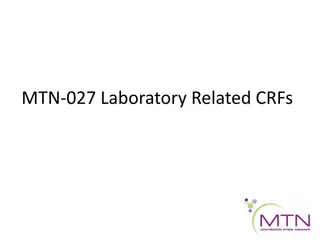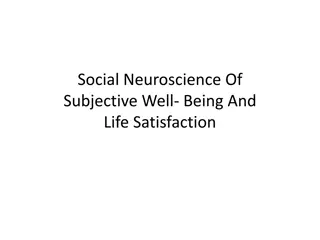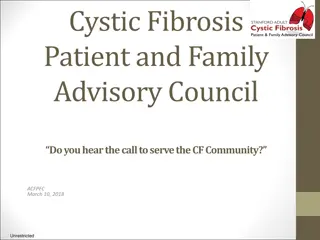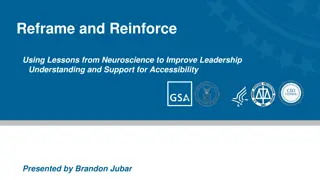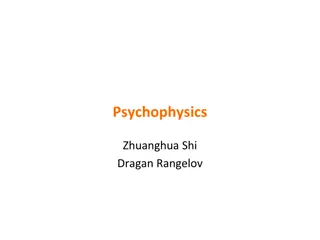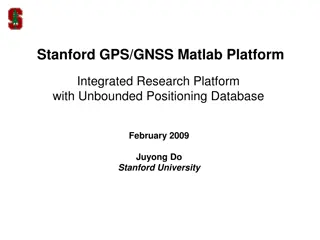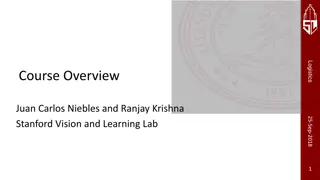Stanford Behavioral and Functional Neuroscience Laboratory (SBFNL)
Conduct cutting-edge research in behavioral and functional neuroscience at Stanford. Explore new equipment, disease models, and advanced monitoring systems for animal studies. Specialized chambers for self-administration studies and microdialysis with sensitive HPLC-MS detection systems.
Download Presentation

Please find below an Image/Link to download the presentation.
The content on the website is provided AS IS for your information and personal use only. It may not be sold, licensed, or shared on other websites without obtaining consent from the author.If you encounter any issues during the download, it is possible that the publisher has removed the file from their server.
You are allowed to download the files provided on this website for personal or commercial use, subject to the condition that they are used lawfully. All files are the property of their respective owners.
The content on the website is provided AS IS for your information and personal use only. It may not be sold, licensed, or shared on other websites without obtaining consent from the author.
E N D
Presentation Transcript
Stanford Behavioral and Functional Neuroscience Laboratory (SBFNL) sbfnl.stanford.edu neurobehavior@stanford.edu
Stanford Behavioral and Functional Neuroscience Laboratory Two locations on the Stanford campus: SIM1 (Lokey Stem Cell Building) and Arastradero, providing testing, housing and laboratory space. The center is operated by a team of experienced full time Staff Scientists and Research Assistants. SIM1 Building Arastradero Building
New equipment and disease models 1
Digilab A home cage monitoring system showing activity level of mice from different vendors. Phenotype transgenic mice, post surgery monitoring, drug screening Continuous live recording of animal for months with cloud based computing 240 cages for high throughput testing
Metabolic cages Urine and feces collection from animal model of addiction or treated with novel treatment E-chiller for storing samples at low temperatures without compromising sample integrity Cages for both rats and mice
Self-Administration Chambers Rats become addicted to heroin that they self-administer, and over several sessions in a specialized cage, increase their active lever presses that deliver heroin. 0 . 1 m g / k g / 0 . 0 5 m g / k g / i n f u s i o n i n f u s i o n 7 0 I n f u s io n 6 0 N u m b e r o f i n f u s i o n o r l e v e r p r e s s ( 3 h ) A c t i v e l e v e r 5 0 I n a c t i v e l e v e r 4 0 16 cagesforrats 3 0 2 0 1 0 0 1 2 6 3 4 5 7 8 9 1 0 1 1 1 2 1 3 1 4 1 5 S e s s i o n
Microdialysis and sensitive HPLC-MS detection systems (DA, NE, Serotonin,..) StanfordPIs usage Heifets, Barron
6-OHDA Convention Enhanced Delivery model of Parkinson s Disease TH levelright striatum Western Blotting Striatal lesion produces a more desirable retrograde and progressive damage of the nigrostriatal system Wider Therapeuticwindow compare to classical 6-OHDA model TH signal treshold - right SNpc 150 4 % of unlesioned SNpc TH/ -tubuline protien level ratio (AUC) 3 100 2 50 1 0 0 Autoxidation to quinone and radical semi-quinone Clockwise rotation 0-40 (5 min. bin) Counter clockwise rotation 0-40 (5 min. bin) 50 Counter-clockwise Rotations 50 6-OHDA-Saline 6-OHDA-7.5mg/KgD-Amph IP 6-OHDA-Saline 6-OHDA-7.5mg/Kg D-AmphIP ClockwiseRotations 40 40 30 30 Oxidation by the MAOB and production ofhydrogen peroxide and other ROS 20 20 10 10 0 0 0 5 10 15 20 25 30 35 40 Time(5 min.bin) 0 5 10 15 20 25 30 35 40 Time(5 min.bin) Total Clockwise rotation 0-40 Total Counter Clockwise rotation 0-40 Counter-clockwise Rotations 400 100 300 Clockwise Rotations 80 60 200 Putative inhibition of mitochondrialcomplex I 40 100 20 0 0 Stanford Behavioral and Functional NeuroscienceLaboratory
-synuclein mouse model of Parkinsons Disease Pathological accumulation of -synuclein in the striatum and the corpus callosum 4 weeks post surgery mice injected with -Syn have lower latency to fall in wire hang test Wire Hang: Average Latency to fall Wire Hang: Average Latency to fall with exclusion 200 200 Vehicle -Syn (5 g/2.5 l) Vehicle -Syn (5 g/2.5 l) Latency to fall (s) Latency to fall (s) 150 150 100 100 50 50 0 0 Baseline PS week 2 PS week 3 PS week 4 Baseline PS week 2 PS week 3 PS week 4 n=1 from vehicle with 28s latency to fall excluded n=1 from -Syn (5 g/2.5 l) with 150s maximum latency to fall excluded Wire Hang: Latency to fall Wire Hang: Latency to fall with exclusion 200 200 Vehicle -Syn (5 g/2.5 l) Vehicle -Syn (5 g/2.5 l) Latency to fall (s) Latency to fall (s) 150 150 100 100 50 50 0 0 Baseline- T1 Baseline- T2 Baseline- T3 PS week 2- T1 PS week 2- T2 PS week 2- T3 PS week 3- T1 PS week 3- T2 PS week 3- T3 PS week 4- T1 PS week 4- T2 PS week 4- T3 Baseline- T1 Baseline- T2 Baseline- T3 PS week 2- T1 PS week 2- T2 PS week 2- T3 PS week 3- T1 PS week 3- T2 PS week 3- T3 PS week 4- T1 PS week 4- T2 PS week 4- T3 n=1 from vehicle with 28s latency to fall excluded n=1 from -Syn (5 g/2.5 l) with 150s maximum latency to fall excluded
Amyloid Beta infusion for 4 weeks causes synaptic degeneration QuantitativeWesternBlot of Contralateralhippocampallysate samples(9 ug/lane) 100 75 50 37 16 31 34 40 55 56 69 76 79 80 26 22 48 51 12 25 PSD95 a-tubulin GAPDH 20 Synaptophysin PSD95 a-tubulin GAPDH synaptophysin R a tio to G A P D H d e n sity (a rb itra ry u n its) S N A P 25 n o rm a liz e d to a v g a cro s s a ll v e h -v e h R a tio to G A P D H d e n s ity (a r b itra r y u n its ) S Y N 1 2 .0 * n o r m a liz e d to a v g a c ro s s a ll v e h - v e h 2 .0 * 1 .5 1 .5 1 .0 Amyloid Beta 1-42 fromrPeptide (0.2mg) (MW AB1-42 is 4513) Formulation: Allow the Abeta 1-42 film to cometo a room temperature forfive minutes. Pipette 20uL Dimethyl Sulfoxide into the bottom ofthe tube. Gently pipette while scraping the sides to ensure Abeta 1-42 goes into solution. Vortex for30 seconds.Add 180uL of 10mM hydrochloride and vortex for15 seconds. Placeto 37C and incubate for24 hours. Toensure that 67ng/hr is delivered via pump, a total of 2.64uL will be deliver in 24 hrs. Therefore, we need 135.2pmol to be deliver in 1 uL. Forthat to happen, in 100uL, 61 uL ofthe stock abeta 1-42 solution is needed and 39 uL of1x phosphate buffered saline to fill each pump. 1 .0 0 .5 0 .5 0 .0 0 .0
Behavioral Paradigms SensorimotorTests: Open field activity test Activity chamber test Basket test Cylinder test Hot plate test Grip strength test Rota-rod performance test Horizontal ladder test Paw misplacement test Inclined platform test Beam walk test Garcia neurological test Twenty-eight point neurological scoring Olfactorytest Catwalk stride test Automated Home Cage activity Running Wheel activity Pre-pulse inhibition IntelliCage CognitiveTests: Learningand Memory: Morris water maze Delayed-Matching-to-Place water maze Barnes maze T maze Y maze Fear conditioning Novel object recognition Novel location recognition Passive avoidance test Conditioned place preference Anxiety: Elevated zero maze Elevated plus maze Light-Dark box SocialTests: Tube dominance test 3 Chamber test Interaction by pair test 5-Trial social memory test 2-Trial social memory test Automated social test Ultrasonicvocalization test Disease Models: Alzheimer's disease Down syndrome Huntington sdisease Parkinson sdisease Autism ALS Addiction Focal ischemia Global ischemia EAE ICV, and other modes of Delivery PK PD BBB permeability studies Non-GLPsafety studies Stanford Behavioral and Functional Neuroscience Laboratory can modify and expand upon existing behavior protocols or design new testing paradigms to best study the behavior you are interested in. ...and many more! 7
Stanford Behavioraland Functional Neuroscience Laboratory can provide expertise in all aspects related to the design and implementation of behavioral experiments as well as data analysis and interpretation. The core is equipped to accommodate a full batteryof behavioral tests relevant to learning and memory, sensory gating, motor function, nociception, and anxiety-related behaviors. Here are some examples of the services we can provide: YMaze Y Maze Spontaneous Alternation is a behavioral test for measuring spatial working memory based on the willingness of rodents to explorenew environments. Rodentstypically prefer to investigatea new arm of the maze rather than returning to one that was previously visited. Many partsof the brain-- including the hippocampus, Fear Conditioning Trace Fear Conditioning (FC) is used to assess Pavlovian learning and memory in rodent models of CNS disorders. Subjects learn to associate a neutral Conditional Stimulus (CS; a tone) with an aversive Unconditional Stimulus (US; a mild electrical foot shock) and exhibit a ConditionalResponse (CR; freezing). After repeated pairings of CS and US, the subjects learn to freezein response to both the tone and training context. The percentage of freezing during a specified time is reported. FC is a useful test for neurobehavioral and genetic studies on transgenic strains of mice, and for pharmacological studies evaluating the effect of novel chemical entities on cognition. septum, basal forebrain, and prefrontal cortex--are involved in this task. This test is used to quantify cognitive deficits in transgenic strainsof mice and evaluate novel chemical entities for their effects on cognition. Morris Water Maze The Morris Water Maze is designed to test spatial memory by observing the subject s ability to find a hidden platform in an opaque water tank. The subject is trained to use visual cues surrounding the tank to locate the platform. Successful learning of the Morris Water Maze is determined by the gradual decrease in the time it takes to find the platform. Ethovision Pro(Noldus Information Technology,Wageningen, the Netherlands) 9 10
Automated Social Test Elevated Plus Maze The Elevated Plus Maze test is used to assess anxiety-related behavior in rodent models. The apparatus consists of a + -shaped maze elevated above the floor with two oppositely positioned closed arms, two oppositely positioned open arms, and a center area. The subjects freely explore the maze as their behavior is recorded. The preference for being in open arms over closed arms is calculated to measure anxiety-like behavior. This test can be used to phenotype strains of transgenic mice and to screen for putative anxiolytic compounds. Sociability:Novel Object; Mouse1 Three Chamber Social Test The Three-Chambertest assesses general sociability and interestin social novelty in rodent models of CNS disorders. Rodents normally prefer to spend more time with another rodent (sociability) and will investigate a novel intruder more so than a familiar one (social novelty). Based on these inclinations, the Three Chamber Test can help identify rodents with deficits in sociability and/ or social novelty. SocialNovelty:Mouse 1; Mouse2 Ethovision XT (Noldus InformationTechnology, Wageningen,the Netherlands) The Automated Social Test is a perfect representation of SBFNL s commitment to continually expand and improve upon existing behavioral paradigms. The Automated Social Test takes the ideas behind the Three-Chamber Social Test and allows scientists to expand the test over several days in a home-cage environment with no disruptions from the experimenter. Furthermore, the design of the chambers enables scientists to modify the difficulty of access to interactions by requiring a certain number of nosepokes to open doors to the interaction chambers. This allows us to distinguish between the desire to socialize and mere exploration. No such test of social motivation currently exists, bringing SBFNL to the forefront.
Automated Home Cage Testing OpenField The Open Field task is a sensorimotor test used to determine general activity levels, gross locomotor activity, and exploration habits in rodents. The animal is allowed to freely move about a large, squarearena for 10 minutes while activity is recorded. The Open Field test is useful for phenotyping transgenic strains of mice and evaluating the effect of novel chemical entities on activity, anxiety, and exploration. Automated Home Cage testing allows scientists to monitor home cage activity levels and behavior of subjects over several days. The addition of running wheels gives an additional way to assess differences in activity. The Automated Home Cage setup is a high- throughput method forscreening subjects after drug treatment or genetic manipulation. Up to 24 cages can be processed at one time. Ethovision XT (Noldus Information Technology, Wageningen, the Netherlands) Ethovision XT (Noldus Information Technology, Wageningen, the Netherlands) Catwalk Olfactory Test The Catwalk is an automated gait analysis system used to assess motor function and coordination in rodent modelsof CNS disorders. Subjects walk across an illuminated glass platform while a video camera records from below. Gait related parameters such as stride pattern, individual paw swingspeed,stance The Olfactory Test is a sensory assay used to measure the olfactory ability, degree of social interest, and perception of social novelty in rodent models of CNS disorders. The nonsocial olfactory test employs water and synthetic odorants while the social olfactory test uses water and urine samples fromother animals. Subjects are exposed multiple times to three different odorants and time sniffing the odor is recorded. The olfactory test is useful for evaluating the effect of novel chemical entities and transgenic modifications on olfactory sensation,discrimination,and sociability. duration, and pressure are reported for each animal. This test is used to phenotype transgenic strains of mice and evaluate novel chemical entities for their effect on motor performance. 13
The Cylinder test is designed to evaluate locomotor asymmetry. As the animal moves within an open-top, clear plastic cylinder, its forelimb activity while rearing is recorded. In MCAO rats, the left forelimb is impaired after stroke. Recovery from stroke can be shown by increased use of the impaired forelimb during the cylinder test. Stanford Behavioraland Functional Neuroscience Laboratory is interested in studying the complex, whole-system effects of disease models and potential treatments. We utilize our expertise in not only BEHAVIORAL testing, but in PHARMACOLOGICAL and DISEASE models to better study neurological disorders and treatments. Behavioral testing in tandem with molecular and cellular biology techniques allows us to provide a complete picture of the systems we study. Here is an example of how this merger of information can provide a full story, leading us to significant and exciting discoveries. Post-treatment and Neuroprotection in the MCAO Rodent Model of Stroke Middle cerebral artery occlusion (MCAO) is a surgicallyinduced cerebral ischemia in rats.In this experiment, we test NeuroprotectionAchieved by CBX CBX treatment post-stroke reduces immediate damage to cerebral tissuecaused by ischemia. the efficacy of a drug (CBX) on inducing neuroprotection when given as a post-stroke treatment. Two main neurological tests are used to assess motor and behavioral deficits in rat models of CNS disorders. Both the Garcia test and the 28 -point Neuroscore test involve a battery of motor tests, ranging from simple observation to traversing a horizontal bar. These tests are well- suited for assessing neurological damage due to ischemia and recovery. Vehicle CBX 3 and 7 h
In addition to behavior testing, Stanford Behavioral and Functional Neuroscience Laboratory creates disease models and performs further analysis via biochemical, histochemical, and pathological evaluation of tissues and samples generated from studies. StereotacticNeurosurgical Procedures Virus and A Injection Intracranial Injection Optogenetics Microdialysis 6-OHDA model of Parkinson sdisease Experimental Stroke Models MultipleSclerosis LPS Induced Cognitive Deficits Experimental AutoimmuneEncephalomyelitis(EAE) HippocampalLesions Morris Water Maze: Spatial ReferenceMemory 90 P<0.05 P<0.05 P<0.01 Escape Latency(s) 75 60 45 Sham Lesion 30 Trial 1 Trial 2 Trial 3 Trial 4 17
In VitroPharmacology Pharmacokinetic & Pharmacodynamic PK/PD) -secretaseassay Bioavailability, biological half-life, elimination rate Blood Brain Barrier Permeability ICV and other modes of drug delivery -secretase is strongly implicated in the pathology of Alzheimer s disease. Thus, modulation of the -secretase may lead to therapeu- tic benefits for the treatment of the disease. In this assay, com- pounds effects on the activity of -secretase are tested using the enzyme substrate, which is linked to a fluorophore at one end and to a quenching agent at the other. 20
Phagocytosis assay with microglia Phagocytosis assay with microglia Mouse/Human Microglia are cultured in vitro to study the effect of the drug/treatment on basic microglia functionality. The cultured microglia are useful in studying drug effects of synaptic pruning and phagocytosis of cell debris. Cell phagocytosis will be evaluated using automated imaging from the Incucyte. Day 7 Day 1 Day 3 HippocampalNeurons LiveCellImaging Phagocytosis Inhibitor Synaptic phagocytosis Automated Phagocytosis Assay pHrodo-labelled -synuclein fibrils pHrodo-labelled amyloid beta fibrils pHrodo-labelled synaptosome neuron BV2 mouse or human microglia synaptosomal preparation pHrodo rat brain pH - 6 Engulfed synaptosomes (pHrodo) by microglia after 6hr pH - 5 pHrodo
Amyloidbetatoxicity assays Cellbased Assays Primary CorticalNeurons(PCN) and PrimaryHippocampalNeurons (PHN) Cell Culture Amyloid peptide (A ) has a central role in the pathogenesis of Alzheimer s disease. In this assay, Embryonic hippocampal/cortical neurons are cultured in vitro to study the effect of the drug/treatment on gene or protein ex- pression. The cultured neurons are also useful in studying the morphology of neurons and synapse formation/density. Cell sur- vival and toxicity will be evaluated using different techniques such as western blotting, qPCR,andimmunocytochemistry. test compounds effect on the A level are studied using the human neuroblastoma cell line stably expressing Swedish mutant amyloid precursor protein. The levels of A produced with or without test compounds are measured with sandwich ELISA. APPToxicityin PCN GPCR(G-proteincoupled receptors) Neurite outgrowth is an important morphological pheno- type of neuronalcells. As the cellular processes are essential for cell health and function, test compounds that can affect the growth of neu- rites may have potential as drugs for neuropatho- logical disorders. In this assay, effects of test compounds on neurite outgrowth are tested with fluorescentstaining. Neurite OutgrowthAssay in PCN andPHN G-protein coupled receptors including adrenergic receptors are one of the most important drug targets. In this assay, effects of test compounds on -adrenergic receptors are studied using the mu- tant inactive luciferase, which becomes active in response to cyclic AMP. Activation of the receptor with -adrenergic receptor agonists lead to the production ofcyclic AMP, which in turn increase the level of luminescence signal producedby the luciferaseactivity.
Biochemical and Histochemical Evaluation LiveCellImaging General histological stains Immunohistochemistry using the ABC/DAB method Immunofluorescence for various cellular markers Biochemical evaluation of samples Day 3 Day 7 Day 1 Neuropathological assessment in models of Alzheimer sDisease Immunohistochemistry Microglia Staining (IBA-1-immunoreactivity) HippocampalNeurons Amyloid Beta PlaqueStaining (6E10-immunoreactivity) Engulfed synaptosomes (pHrodo)by microglia after6hr Non-GLP Safety and Pathological Evaluation Amyloid BetaPlaqueLoad WesternBlot ELISA QuantitativertPCR RelativeGeneExpression
Contact Us For more information about Stanford Behavioral and Functional Neuroscience Laboratory, please visit our website at http://sbfnl.stanford.edu, or contact : Nay L. Saw Core Manager nsaw@stanford.edu (650) 725-2918 neurobehavior@stanford.edu FY2022 Rates Service Scientific Advisory Board FY22Rate/Hr Dr. Mehrdad Shamloo (Director of Behavioral and Functional Neuroscience Laboratory, Associate Professor of Neurosurgery) Dr. David Lyons (Professor of Psychiatry & Behavioral Sciences) Experiment performed by BFNL Staff $168 Dr. Katrin Andreasson (Associate Professor of Neurology) Dr. David Yeomans (Associate Professor of Anesthesiology, Perioperative and Pain Medicine) Facility/BFNL EquipmentUse $72 Dr. Joseph Garner (Associate Professor of Comparative Medicine, Psychiatry and Behavioral Sciences) Dr. Frank Longo (George E. and Lucy Becker Professor in Medicine, Professor of Neurosurgery) Technical Procedure RoomUse $18-55 * Indirectcost(IDC) 57.7% Only for external users
